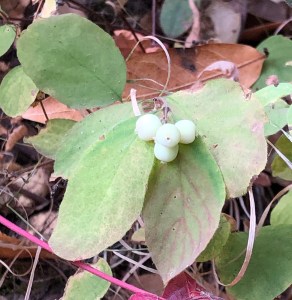
Trailing Snowberry, Trip Vine
Symphoricarpos mollis
NATIVE
Description (Jepson, PlantID.net)
- Eudicotyledon
- Eudicots are a major lineage of flowering plants; see family for general characteristics
- Honeysuckle Family (Caprifoliaceae)
- Deciduous shrub
- Low-growing, sprawling
- Reproduces by rhizomes (horizontal underground stems), rooting from stem nodes (layering), and, rarely, from seeds
- Forms large clonal colonies
- Stems
- Narrow, flexible, and often rooting
- Leaves
- Opposite (2 leaves at each junction with stem)
- Generally oval, thin, and soft-hairy on both sides
- Entire (with smooth edges), wavy, or slightly lobed
- Flowers
- Inflorescence (flower arrangement) is a terminal raceme (unbranched stem with stalked flowers opening from the bottom up)
- 2-8 small, bell-shaped flowers
- Buds are pink, turning white
- Nectary gland below each of the 5 corolla lobes produces copious nectar
- Ovary inferior (below the attachment of other flower parts)
- Inflorescence (flower arrangement) is a terminal raceme (unbranched stem with stalked flowers opening from the bottom up)
- Fruit is a white, spongy, berry-like drupe (a fleshy fruit with usually 1 seed in a hard inner shell — a stone fruit), containing 2 nutlets
- Height to 2 ft.

Distribution
- Native to California
- Grows in woodlands, along stream banks and north-facing slopes
- See Calflora for statewide observations of this plant
- Outside California, grows from British Columbia to Oregon, and into Idaho and New Mexico
- Grows at elevations to 9,840 ft.
Uses (San Mateo County Parks prohibits removal of any natural material)
- Wildlife
- Flowers attract hummingbirds; butterflies, e.g. variable checkerspot (Euphydryas chalcedona); moths, e.g. elegant sheepmoth (Hemileuca eglanterina) and one-eyed sphinx (Smerinthus cerisyi); and many other pollinators
- Berry-like fruits are an important food source for many birds and mammals
- Leaves browsed by deer
- Habitat and cover for birds and small mammals
- Native people
- Medicinal uses
- Infusion of berries used for an eye wash
- Tool uses
- Hollow stems used for pipe stems and for arrow shafts for small bird hunting
- Bushes were actively managed by pruning and burning, stimulating many positive effects (Anderson 2005)
- Vigorous and straighter shoots
- Larger and more numerous fruits
- Less congested canopies
- Reduced insect infestations
- Recycled nutrients
- Medicinal uses
- CAUTION – fruit contains saponins, which are considered toxic
- These berry-like fruits have such an unpleasant, soapy taste that one is not likely to eat a toxic quantity; best to leave them for wildlife

Name Derivation
- Symphoricarpos (sim-for-i-KAR-pos) – from the Greek symphorein, “bunched together,” and karpos, “fruit,” referring to the fruit clusters
- mollis (MOLL-is) – from the Latin for “soft,” referring to the soft hairs on the leaves
Notes
- Geophytes (e.g. plants growing from bulbs, corms, rhizomes, or enlarged taproots) are well adapted to survive fire, our Mediterranean climate’s long, dry summers, and extended droughts
- Above-ground growth dies back after flowering, while underground the plant survives with stored water and nutrients
ID Tips
- May be confused with common snowberry (S. albus var. laevigatus)
| Creeping Snowberry | Common Snowberry | |
| Growth Habit | sprawling, low-growing | upright |
| Height | ≤ 2 ft. | ≤ 6 ft. |
| Inflorescence | 2-8 flowers | 8-16 flowers |
| Flowers | symmetrical (nectary at base of each lobe) | asymmetrical (one bulging lobe contains all 5 nectaries) |

© Regents of the University of California
At Edgewood
- Found in woodlands
- See iNaturalist for observations of this plant
- Flowers April – June
- Fruits persist into winter
Specific references
Allshouse, D., and D. Nelson. 2022. San Bruno Mountain: A Guide to the Flora and Fauna. HeyDay, Berkeley, California.
Anderson, M.K. 2005. Tending the Wild. University of California, Berkeley. Pp. 234-235.
Beidleman, L.H., and E.N. Kozloff. 2014. Plants of the San Francisco Bay Region: Mendocino to Monterey. University of California, Berkeley. Pg 150.
Prigge, B.A., and A.C. Gibson. 2013. Symphoricarpos mollis. A Naturalist’s Flora of the Santa Monica Mountains and Simi Hills, California. Web version, hosted at Wildflowers of the Santa Monica Mountains National Recreation Area. United States Department of Interior, National Park Service.
Regents of the University of California. Symphoricarpos albus var. laevigatus [Illustration of nectaries, adapted]. Jepson eFlora. Jepson Herbarium. University of California, Berkeley.
Regents of the University of California. Symphoricarpos mollis [Illustration of nectaries, adapted]. Jepson eFlora. Jepson Herbarium. University of California, Berkeley.
Snyder, S.A. 1991. Symphoricarpos mollis. Fire Effects Information System. United States Department of Agriculture, Forest Service, Rocky Mountain Research Station, Fire Sciences Laboratory.
General References
Calflora Database. 2014. Berkeley, California.
Calscape. 2018. California Native Plant Society.
Charters, M.L. 2015. California Plant Names: Latin and Greek Meanings and Derivations.
Charters, M.L. 2017. Southern California Wildflowers: Guide to the Pronunciation of Specific, Generic and Family Names.
Corelli, T. 2004. Flowering Plants of Edgewood Natural Preserve (2nd. ed.). Monocot Press, Half Moon Bay, California.
Elpel, T.J. 2013. Botany in a Day: The Patterns Method of Plant Identification. HOPS Press, Pony, Montana.
Flora of North America. efloras.org.
Harris, J.G., and M.W. Harris. 2013. Plant Identification Terminology: An Illustrated Glossary. Spring Lake Publishing, Spring Lake, Utah.
Keator, G. 2009. California Plant Families. University of California Press, Berkeley and Los Angeles, California.
Native American Ethnobotany DB.
Regents of the University of California. Jepson eFlora. Jepson Herbarium. University of California, Berkeley.
